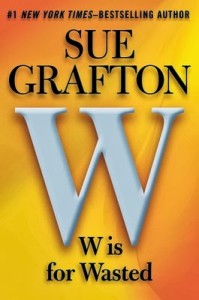By Elaine Viets
How do you write a mystery?
There are whole books on this subject.
But the best short advice is in Grafton’s new Kinsey Millhone novel, “W Is for Wasted.”

Private eye Kinsey Millhone talks about how she started investigating two mysterious deaths. One victim was a sleazy PI and the other was a homeless man.

Kinsey was drawn into the mystery by a call from the coroner’s office. The coroner was “asking if I could ID a John Doe who had my name and phone number on a slip of paper in his pocket,” Grafton wrote. “How could I resist?”
That had me hooked. But then Kinsey explained how to write a mystery:
“Every good mystery takes place on three planes – what really happened; what appears to have happened; and how the sleuth, amateur or professional (yours truly in this case) figures out which is which.”
There it is. The art of mystery writing in one succinct sentence. We writers are supposed to set up the story for the readers, help them find out what really happened, and tell it, giving enough clues to play fair but not give away the ending.

Grafton gives us another dollop of advice in Kinsey’s next sentence:
“I suppose I could put everything in perspective if I explained how it all turned out and then doubled back to that phone call,” she wrote, “but it’s better if you experience it just as I did, one strange step at a time.”
New writers and experienced ones need to remember Kinsey’s advice: Tell the story, one strange step at a time.
Many newbies try to be too clever. They don’t have the skills to deliver a twisted tale. They get lost in the maze they created.

Experienced writers get bored with the format after writing book after book. We try to start in the middle, or start at the end, or switch narrators, often to amuse ourselves. Too often, it simply confuses our readers.

Following the straight path, in Grafton’s footsteps, can be far more difficult. But she kept me interested for 496 pages. She also made me care about two people society considers worthless: a crooked PI and a homeless man who doesn’t even have a name.
How did Grafton pull it off? Read it yourself.
I guarantee your time won’t be wasted.

A link to the book would be nice :o)
Your wish is my command, Lexi. It’s a tree book, an e-book and an audio book.
http://www.barnesandnoble.com/w/w-is-for-wasted-sue-grafton/1115230603?ean=9780399158988
There’s an old joke about a guy with a pet squirrel. He goes into a bar and says his squirrel writes mysteries. The bartender says, “How can a squirrel do that?” And the guy says, “He starts at the end and works his way back.”
Anyway, there’s always a good deal of talk about whether to “pants” your way through or know the ending first. I personally have come to appreciate Erle Stanley Gardner’s method of “the murderer’s ladder.” You first work out steps of the murderer’s actions, from motive to final act. One of those rungs on the ladder is going to give him away. That was the genius of the old Columbo shows. We saw the murder unfold at the beginning, then watched Columbo examine the rungs.
Another Columbo fan. I watch those old shows as guidelines on how to write a good mystery. Like the “Murderer’s Ladder.”
This comment has been removed by a blog administrator.
Love this short but simple advice – now if I could just follow it! Also love JSB’s murderer’s ladder reference…another great approach. Though I confess I’m not a huge Colombo fan:(
I’m not a fan of Columbo’s rumpled raincoat — it looks like some of the clothes I’m trying to get my husband to bag. But revisit a show or two to for the plot structure. It is well done.
Can’t wait to read this now, Elaine–thanks for the tip!
Good advice from a master, Elaine. Sort of a variation on KISS…keep it simple stupid. In other words, tell a good linear story and forget about razzle-dazzle.
Advice I need to revisit myself, Kris, as I work on book number 22.
If I am starting to get bored, I’ll send my characters to a new location for one book. Thus they’ve solved mysteries at a haunted hotel, on a cruise ship, and now at a dude ranch in Arizona. It gives me a change of pace along with the scenery.
Not only a good cure for writer’s boredom, but tax deductible!
So we should send our characters and ourselves to Buchercon 2014 in Long Beach. I’m booked and looking forward to partying under the TKZ Tent!
I’ll be there, too, Jim. Can’t wait for Bouchercon. Helen Hawthorne can share my room, but only if she pays half.
Hmm, I always thought Grafton was an example, like Patterson, of an author who has become a wee bit formulaic. I guess you can’t argue with success, though.
Sure you can argue, Steven. That’s why we’re here. I thought her alphabet series sagged around L but think she’s back on track again. And even if you don’t like Grafton’s writing, her advice is good.
can’t tell you how happy it made me to read “…it’s better if you experience it just as I did, one strange step at a time.” – thanks so much!
You’re welcome. I like that bit, too.
Short advice is the best, because I can remember it! Thanks
What is even more amazing is that Grafton has kept readers interested for 23 books in her series. That is true talent. She obviously knows how to tell a good mystery!
Like your series, Elaine, I am super impressed that an author can come up with compelling stories time after time. Especially on your tight schedule! Also like the Kinsey books, I think your series of Dead End Jobs is getting better and better (although, I’m partial to number eleven, FINAL SAIL) 🙂
Victoria Allman
Author of: SEAsoned: A Chef’s Journey with Her Captain